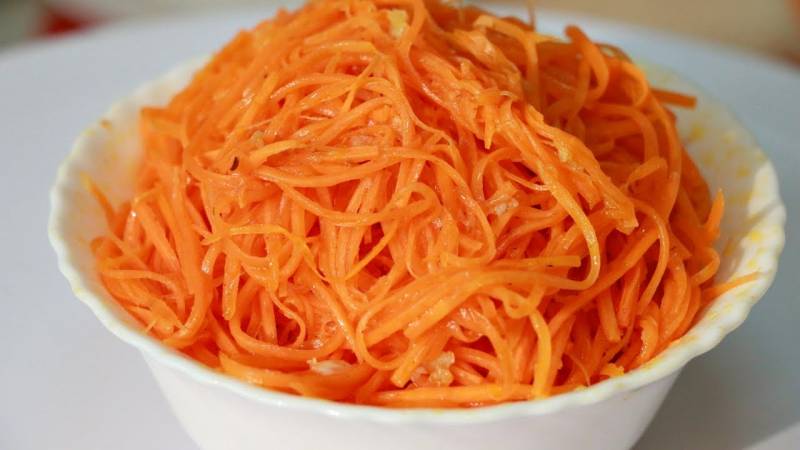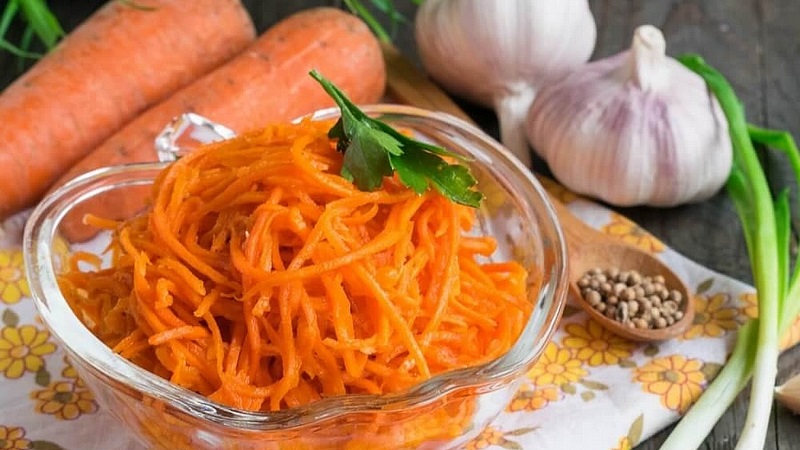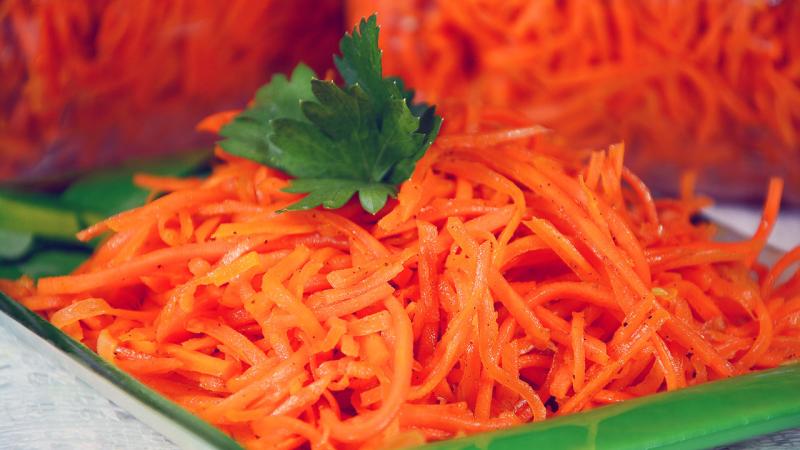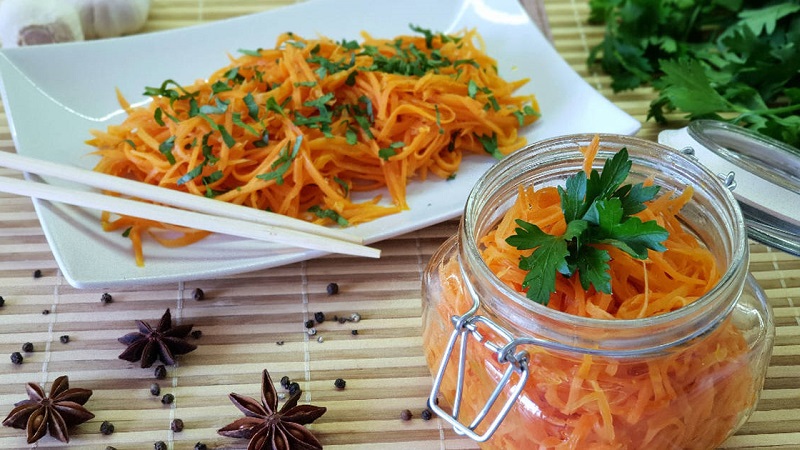How and how long to store Korean carrots in the refrigerator
It is difficult to imagine traditional Russian cuisine without carrots. This root vegetable is used in almost every dish. And if earlier it was fried, steamed and boiled, now it is pickled.
Korean-style carrots have become very popular. How long such carrots are stored in the refrigerator, is it really useful and is it possible to eat this dish for those who monitor their diet - read all this in our article.
The content of the article
Chemical composition of Korean carrots
Traditional Korean carrots are prepared using vinegar, coarsely ground red hot peppers, garlic, salt, sugar and sunflower oil. For juiciness and disclosure of taste, the dish is infused for 1 day.
Carrots are rich in vitamins and minerals. Cooking salad in Korean allows not only to preserve nutrients, but also to enrich them.

The composition of 100 g of the product includes:
- starch and dextrins - 1.1 g;
- ash - 1.1 g;
- mono- and disaccharides - 5.3 g;
- water - 75.3 g;
- polyunsaturated fatty acids - 0.004 g;
- organic acids - 111.5 g;
- dietary fiber - 4.8 g
The content of minerals in 100 g of the product is shown in the table.
| Substance | amount |
| Nickel | 4.6 μg |
| Aluminum | 247.5 μg |
| Lithium | 4.6 μg |
| Cobalt | 2.3 μg |
| Vanadium | 75.9 μg |
| Boron | 153.3 μg |
| Molybdenum | 18.5 mcg |
| Fluorine | 42.1 μg |
| Chromium | 2.3 μg |
| Manganese | 0.1907 mg |
| Copper | 73.9 μg |
| Iodine | 4.2 μg |
| Zinc | 0.362 μg |
| Iron | 0.7 mg |
| Sulfur | 9.8 mg |
| Chlorine | 1764.6 mg |
| Phosphorus | 45.9 mg |
| Potassium | 163.7 mg |
| Sodium | 27.3 mg |
| Magnesium | 30.3 mg |
| Calcium | 38 mg |
Vitamin content per 100 g of product:
| Vitamin | amount |
| RR | 0.9992 mcg |
| H | 0.05 μg |
| E | 3.9 mg |
| FROM | 4.2 mg |
| A, RE | 6.9 mg |
| IN 1 | 0.05 mg |
| AT 2 | 0.06 mg |
| AT 5 | 0.2 mg |
| AT 6 | 0.1 mg |
| AT 9 | 6.9 mcg |
| Niacin | 0.8 mg |
Calorie content, BJU and glycemic index
Calorie content of carrots in Korean is 112.6 kcal per 100 g. The salad is considered low-calorie due to its high fiber content.
Nutritionists recommend using it for people on a weight loss diet.
Energy value of 100 g of product:
- proteins - 1.2 g;
- fats - 8.2 g;
- carbohydrates - 9 g.
The glycemic index of carrots in Korean is 63.15.
Beneficial features

Korean carrots are not only tasty, but also a healthy dish.
Lettuce properties:
- replenishes the deficiency of vitamins and minerals;
- improves the functioning of the digestive system, eliminating constipation;
- has a beneficial effect on vision;
- improves the condition of the capillaries;
- speeds up metabolism;
- increases appetite.
Act:
- vasodilator;
- antihelminthic;
- antiseptic;
- antiviral;
- expectorant;
- choleretic;
- diuretic.
Carrots are served as a salad or used in other dishes. The snack is especially useful during colds, as it neutralizes dangerous bacteria due to garlic. Its regular use helps to improve the condition of the heart and blood vessels.
The dish is contraindicated in case of diseases:
- liver;
- kidney;
- pancreas;
- stomach;
- bowel disorders;
- diabetes mellitus.
How to properly store carrots in Korean
The dish does not contain perishable food, but this does not mean that it has no shelf life. Vinegar is used as a preservative.
Home cooking
Korean carrots stored in a refrigerator in a sealed container.If you leave the salad on a plate, it will begin to dry out by 3 days. Plastic containers or glass jars with a lid are used as containers. If you plan to eat the salad quickly, it is permissible to keep it in a saucepan for several days.
The salad is stored in the refrigerator at a temperature of 0 ... + 5 ° C. When exposed to sunlight, carrots will deteriorate in just a few days. Air drying makes the snack unappetizing and unusable.

Shop
Experts believe that a good store product has a bright orange color. If the salad is pale yellow shade, which means that the manufacturer used low-quality raw materials or unsuitable carrots varieties.
The carrots should be crispy. If it is soft, then the salad was prepared a long time ago. To achieve a marketable appearance, sellers mix old and fresh products. When buying a snack, it is important to make sure in what conditions it is stored. According to SanPiN, Korean carrots should be stored at a temperature of 0 ... + 4 ° C.
Important! Do not buy ready-made snacks from open shelves.
The closed packaging of the salad is stored in a cool place, where the sun's rays do not fall. Since there is no information on what proportions of ingredients the manufacturer used, it is better to place the product in the refrigerator. After opening the package, the salad is transferred to a resealable container. Air ingress will acidify the carrots.
Shelf life of Korean carrots in the refrigerator
In the refrigerator, Korean carrots are stored in plastic containers with a lid. The product is prepared using natural preservatives, but its quality can affect shelf life. When preparing a salad, it's important to make sure all the ingredients are fresh.
Important! To prevent spoilage, the container is shaken from time to time to ensure an even distribution of vinegar and oil.
Home cooking

Home-cooked carrots are believed to last longer. The hostess is guaranteed to use quality food, and also puts in a sufficient amount of vinegar, salt and pepper.
Important! The dish is suitable for consumption within 14-20 days.
The longer the salad is stored, the worse it tastes, so it is better to eat it in 2-3 days, when the carrots are most juicy.
To save space in the refrigerator, lettuce is frozen. Carrots are laid out in portions in packages. Put in containers blankrequired for only one dish. The shelf life of the workpiece is up to 6 months. It is worth considering that after defrosting the vegetable will lose its elasticity, so this salad is used to add to other dishes.
Shop
Each product package has an expiration date... According to the SanPiN standards, carrots are suitable for consumption within 48 hours after the end of the technological process.
The open package of salad is stored in the refrigerator. To prevent the carrots from getting windy, they are poured into a hermetically sealed container.
Storage tips and tricks
It would seem, what could be easier than storing carrots in the refrigerator? But it turns out that even in this case there are small tricks:
- Divide the snack into 3-liter jars. For example, if you get 2 cans, tamp it tightly into 1. Distribute the remainder in liter containers. First use a salad from small jars, then open the preparation from a large one. Divide it into small containers. Carrots will sour faster if air gets into the jar.
- The shelf life of carrots depends on which compartment of the refrigerator they are stored in. The salad will not spoil on the main shelves and in the freshness zone for vegetables and fruits.
- To prevent the salad from souring ahead of time, when preparing it, pay attention to the sanitization of the equipment. Wash all graters and containers with laundry soap and pour over boiling water. Use sterilized jars for storage.
Conclusion
Korean carrots have long been included in the list of holiday dishes.This is not only delicious, but also healthy salad, it is suitable even for those who watch their diet.
It is not difficult to prepare such a snack, even an inexperienced hostess can handle it. Store the salad in the refrigerator in hermetically sealed containers. The maximum shelf life of carrots is 15 days, but if you keep them in the freezer, the period increases to six months. It is better to give preference to a home-made product, but if there is no time for cooking, manufacturers will come to the rescue. The salad is considered fresh within 48 hours of production.